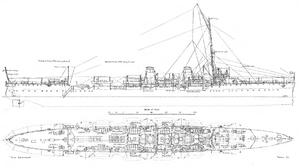 Line drawings of the Bahia class
| |
| Class overview | |
|---|---|
| Name | Bahia class |
| Operators | |
| Built | 1907–1910 |
| In commission | 1910–1948 |
| Planned | 3 |
| Completed | 2 |
| Cancelled | 1 |
| Lost | 1 |
| Scrapped | 1 |
| General characteristics | |
| Type | Scout cruiser |
| Displacement | 3,100 t (3,100 long tons)[1][2] |
| Length | |
| Beam | 11.89–11.91 m (39 ft 0 in – 39 ft 1 in)[2] |
| Draft | |
| Propulsion |
|
| Speed | |
| Endurance | |
| Complement | 320[3] to 357[2] |
| Armament |
|
| Armor |
|
| Notes | These specifications apply to when Bahia was commissioned. |
The Bahia class was a pair of scout cruisers built for Brazil by Armstrong Whitworth in the United Kingdom, based on a design that borrowed heavily from the British Adventure-class scout cruisers. The class comprised the lead ship Bahia and her sister Rio Grande do Sul, along with a canceled third ship, Ceara.[4] Both were named after states of Brazil. As a class, they were the fastest cruisers in the world when commissioned, and the first in the Brazilian Navy to use steam turbines for propulsion.
In the mid-1920s, both ships were extensively modernized with three new Brown–Curtis turbine engines and six new Thornycroft boilers, and, in the process, was converted from coal-burning ships to oil-burning. The refit resulted in a striking aesthetic change, with the exhaust being trunked into three funnels, instead of two. The armament was also modified; three 20.1 mm (0.79 in) Madsen guns, a 7 mm (0.28 in) Hotchkiss machine gun, and four 533 mm (21.0 in) torpedo tubes were added.
In the Second World War, both were used as convoy escorts. On 4 July 1945, Bahia was lost after an accident caused a massive explosion which incapacitated the ship and sunk her within minutes, resulting a large loss of life. Rio Grande do Sul survived the war and was scrapped in 1948.